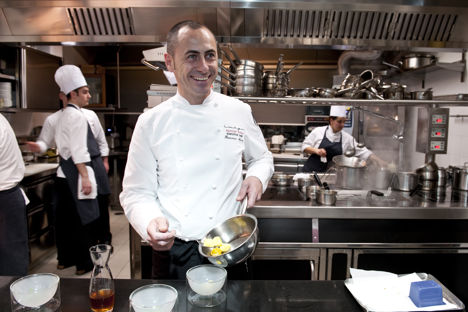
Indo-Italian: the fusion cuisine of Francesco Apreda
Tom Riby talks to the Michelin-starred chef about his love for India and how he uses the country’s spices to breathe new life into Italian cuisine.
Indo-Italian: the fusion cuisine of Francesco Apreda
Tom Riby talks to the Michelin-starred chef about his love for India and how he uses the country’s spices to breathe new life into Italian cuisine.
In 2004, chef Francesco Apreda (along with Roberto Wirth, the owner and Director of Hotel Hassler in Rome) set out to open two Italian restaurants in India – one in Mumbai and another in New Delhi. Eight years later, both restaurants have become bastions of Italian cooking in the country, and Francesco’s idea of fusing Indian ingredients with Italian cuisine has become an international success.
It was Francesco’s own experiences of India’s rich, diverse cuisine that encouraged him to return to the country time and time again. ‘How can you not fall in love with India? Many people say I love it, I hate it, I adore it, but every time I go there I can not wait to return,’ he says. ‘I went to India ten years ago and taught chefs there how to make real Italian food. But I soon found out many people could already make homemade pasta and even sell it. Their version is pretty good.’
Francesco claims India is a country that enriches and purifies your soul with its many colours and friendly faces, and introducing Italian flavours into Indian culture is a welcoming change for the locals. ‘On my last trip to Mumbai, we proposed a menu of thirteen special dishes from Imàgo [Francesco’s restaurant] with white truffles from northern Italy,’ he tells me. ‘Both the chefs and guests had never seen or tasted truffles before and the smell was intense. In a suitcase along with my chef's jackets I had two kilos of them – my clothes smelled of truffles and the intensity of it all impressed everyone. They were amazed by the wonderful aroma and now I am expected to bring truffles every time I come to India!’
Welcome change
India has certainly changed in the past ten years. With a growing economy and middle class that’s doubled in size since 2004, the country is evolving rapidly. ‘Something is changing across India,’ says Francesco. ‘Every time I go back I find new roads, new bridges, new buildings and many new five-star hotels. It’s a country that runs fast, is always ready to innovate and ready to open up to new cultures. It’s encouraging to see, especially the way tradition continues to be embraced alongside new cuisines.’
At first, the food of Italy and India seems a world apart. But on closer inspection, there are some similarities, which is why Francesco has found success in combining the two. ‘In Italy, especially in the south, we use lots of spices, even though our cuisine is generally not considered spicy,’ he explains. ‘When I went to India for the first time, I struggled to taste certain things as the food was too spicy for me, too strong. Over the years, however, my taste buds and palate has developed. Now every time I go there I always come back to Italy with large bags of spices and encourage all my chefs to keep trying them to help educate their palates.
Francesco Apreda
‘Last year, for example, I discovered black cardamom,’ he adds. ‘It’s incredibly strong and not something I would have enjoyed years ago, but now because my palette has developed I can detect its many delicate flavours. I always think about Italian food when I discover a new Indian spice, and always research how it’s traditionally used before developing a new dish centred around Italian traditions.’
This combination of Italian and Indian flavours can be seen in Francesco’s dishes both at Imago and his restaurants in India. Recipes such as Sfogliatelle samosas with green tea ice cream and berry sauce and Tandoori duck breast with duck croquettes, apricots and pak choi show how worldly the chef’s larder has become. ‘Thanks to my travels and influence from abroad, the flavours of the world have been welcomed into my kitchen,’ he says. ‘As well as Indian, I have also introduced flavours from Japan, America, the UK and Thailand through the range of spices I use. It’s the hints of flavour from other countries that gets me excited.’


